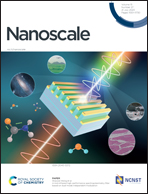Uniform nucleation and growth of Cs3Cu2I5 nanocrystals with high luminous efficiency and structural stability and their application in white light-emitting diodes†
Abstract
Copper-based ternary halide composites have attracted great attention due to their superior chemical stability and optical properties. Herein, we developed an ultrafast high-power ultrasonic synthesis strategy to realize the uniform nucleation and growth of highly luminescent and stable Cs3Cu2I5 nanocrystals (NCs). The as-synthesized Cs3Cu2I5 NCs show uniform hexagonal morphology with an average mean size of 24.4 nm and emit blue light with a high photoluminescence quantum yield (PLQY) of ∼85%. Moreover, the Cs3Cu2I5 NCs exhibit a remarkable stability during continuous eight times heating/cooling cycling tests (303–423 K). We also demonstrated an efficient and stable white light-emitting diode (WLED) with a high luminous efficiency (LE) of 41.5 lm W−1 and a Commission Internationale de l'Eclairage (CIE) color coordinate of (0.33,0.33).

- This article is part of the themed collection: Celebrating 25 years of the Key Laboratory for Special Functional Materials at Henan University


 Please wait while we load your content...
Please wait while we load your content...